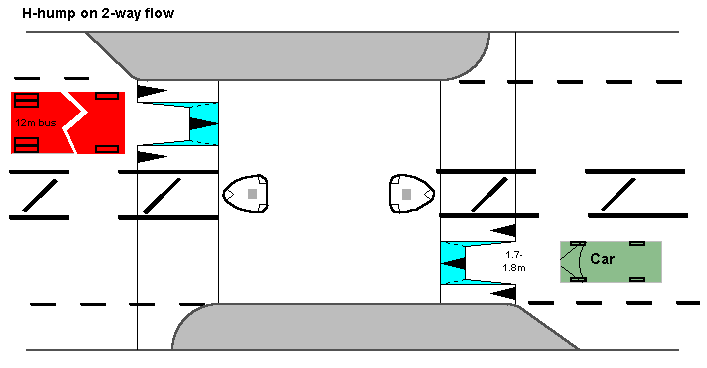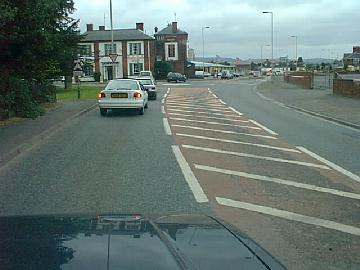 |
Mini-roundabouts & Traffic
Calming
|
| Well justified, a mini-roundabout
will, in itself, act as a useful traffic calming
feature. Drivers will expect to give way at the
site and this will result in speed reduction.
Problems arise when traffic engineers assume that
a mini-roundabout can be installed just to
control traffic speeds when there may not be much
turning traffic. In this circumstance drivers
tend to "run through" the
mini-roundabout not expecting to yield much,
in some cases very little. If you
expect problems with your site as there is low
flow and relatively little side-road traffic, try
making the central island a feature in itself. I
have recommended the use of a mini-roundabout of
up to about 8m diameter in a crossroads of ICD
20m just to ensure adequate deflection. The
roundabout would operate on the basis of single
file entry and probably using overrunnable
splitter islands. I now recommend using shallow
kerbs as a deterrent raising the whole centre by
about 75mm, ensuring that drivers cannot cut
straight across the central island and so have to
treat the roundabout with respect.
|
It is
important to ensure that drivers will expect to
give way. An exception to this may be where there
are several mini-roundabouts along a route which
is being traffic calmed - safety in numbers may
work out. I have seen a few such schemes and they
seem all right. It is the isolated
mini-roundabouts that were never justified in
their own right that so often seem to come into
my seminars as problem sites. Main road traffic
calming
I am looking
forward to getting much better control of speeds
on main roads through villages and towns using
mini-roundabouts and differential slope vertical
deflections, (i.e. speed cushions, H and S-ramps)
where the steepness of the vertical deflections
is dependent upon the effective wheel track of
the approaching vehicle. Buses and larger
vehicles including most emergency vehicles suffer
less vertical acceleration than cars and light
vans and if the design is right should be able to
traverse at about the same speed.
|
Here is the form of
H-hump on a wide two-way road that many will have
seen demonstrated in my seminars. I have seen one in
use at Feltham, a pair on a bus route on the
outskirts of Belfast and a series in Glenrothes,
Scotland; let's get using these, perhaps at some
trial sites first.

|
| The H-hump.
This device has great potential for use on
main roads where there are problems with speeds,
but genuine pedestrian facilities are needed at
footway level. While pedestrians often demand
light control, the safety of Pelicans and signal
junctions is doubtful. Some H-humps have been
installed in Scotland in Fife but there they
incorporate the dug-out area on the exits ramps
from the table which I consider unnecessary. Also
they assumed that drainage gullies will be needed
which will rarely be the case. On most reasonably
level roads the side-fall is usually more
significant than the longitudinal fall.
|
In Borehamwood traffic
speeds along Shenley Road are controlled
by mini-roundabouts, single
lane dualling and ordinary speed tables. The
buses are at some disadvantage and need a
facility such as the H-ramp to reduce their
vertical accelerations, while increasing the
vertical accelerations for light vehicles.
|
An interesting
example of main road traffic calming with
mini-roundabouts occurs at Craven Arms in Shropshire.
This site came into my seminar at Shrewsbury in July 1999
and is reported in DETR Traffic Advisory Leaflet 2/97 - Traffic
calming on major roads: A49, Craven Arms, Shropshire.
See also TA 1/98 - Speed Cushion Schemes.
Various views of A49 Craven
Arms, Shropshire
(The
site has not been visited since these images were taken
in July 1999.)
|
|
| Note in these
two views the smooth alignment of the carriageway
and note in particular the misleading effect of
the bifurcation arrows which really must not be
used at mini-roundabouts. |
Note the visual
clutter of the hatching; the use of different
colour surfacing may be effective but the whole
thing would be better if we would make our
painted islands solidly marked and not hatched. |
|
|
| In
this view approaching the southern
mini-roundabout from the south, note the
superelevation, the lack of indication by the
street lighting of the mini-roundabout and the
false impression that the hatching could just
lead to a refuge! There are virtually no clues on
the ground that this has to be the approach to a
mini-roundabout! |
This
view is no better; although I can see the
mini-roundabout (just), it is not that
conspicuous and the approach layout fails to
attract my attention or slow me down. If we are
going to be successful in reducing accidents at
mini-roundabouts the approach layouts really must
do better than this. |
Concern was
expressed by Shropshire CC that the
northernmost mini-roundabout had very low
side-road flow and was hardly justified - I
am inclined to agree. But I am also concerned
about a number of design faults along the
route through the village that I think should
be rectified:
|
| 1. The use of bifurcation
arrows Although extremely close to the
mini-roundabout give-way lines, bifurcation
arrows have been used on several approaches, but
these are misleading to drivers giving the false
impression of a priority junction. These
arrows should be removed. 2. The street lighting This
fails to highlight properly the presence of the
junction; at least three units are needed
over each junction, one on each corner.
|
3. The superelevation
Probably one reason why the scheme was
installed in the first place - the southern
mini-roundabout is placed on a slight curve in
the A49 and it is noticeable that the carriageway
is super-elevated. No attempt has been made to
remove this - probably too expensive, but
observers should note that the need for
super-elevation in urban areas must be very rare
indeed and it is extremely important not to
create new problems by including this in designs
which sadly I have noticed all too often. 4. The clutter
The different surface colours and the
hatching all conspire to hide rather than clarify
the junction layouts.
|
Lessons
to be learnt:-
Just
"dropping in" one or more
mini-roundabouts is rarely enough;
Clearer
layouts are needed - avoid all that hatching;
Think
twice before using mini-roundabouts with low
side-road flows;
Don't
build super-elevated highways in the first place!
General Comment
I am very pleased to see villages where
mini-roundabouts are being used to deal with excessive
speed in such an environment, and I am pleased too to see
the use of vertical deflections. In time we will develop
the use of more sophisticated vertical deflections such
as H- & S- humps which are more helpful to
pedestrians and, combined with mini or small roundabouts,
will secure good speed and environmental control in
villages and urban main roads currently plagued with
excessive and intimidating traffic.
Links
to other pages:
© Penntraff - Dec 2014
Pages
designed by:
|





